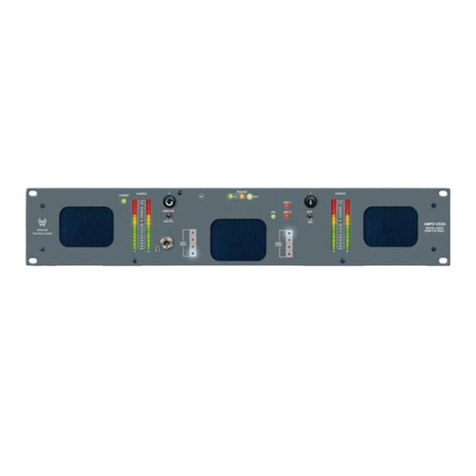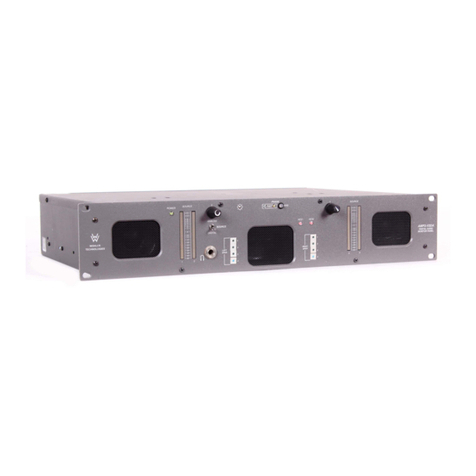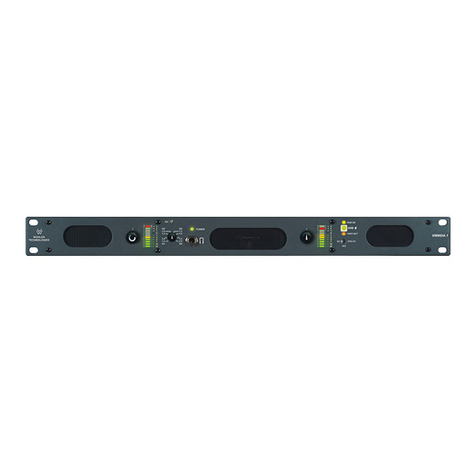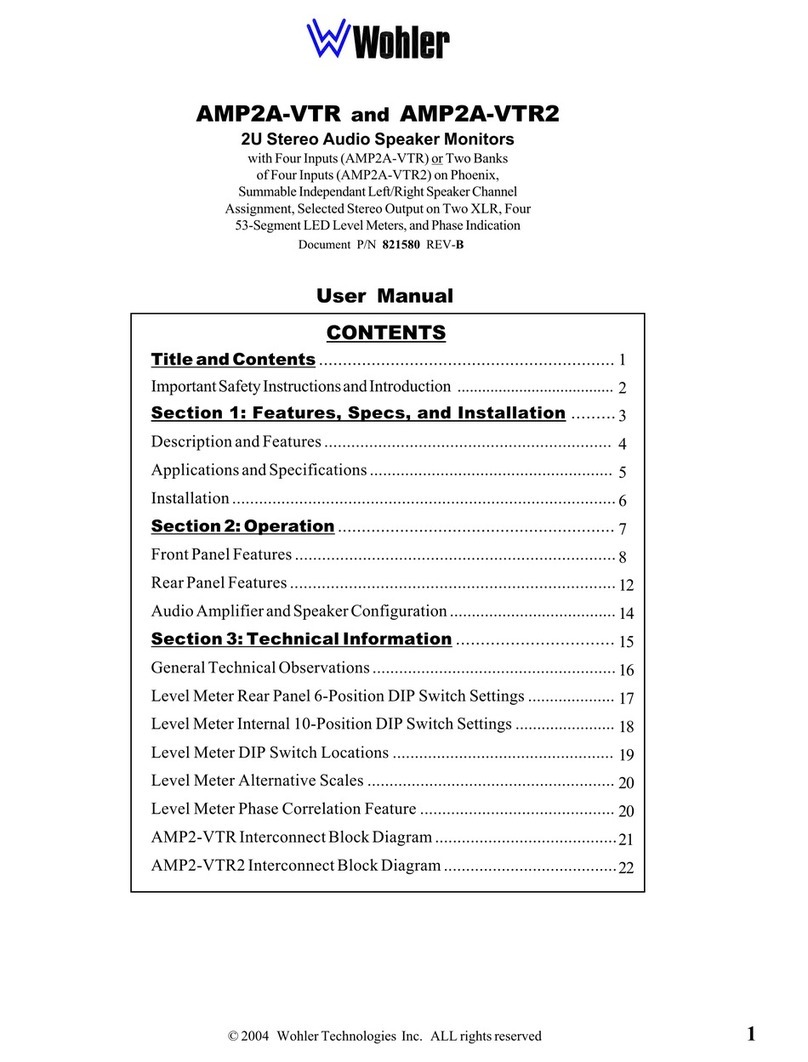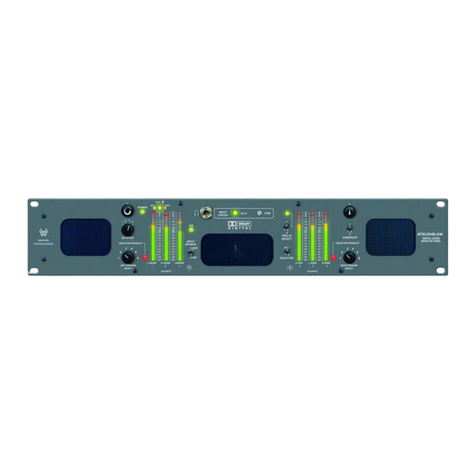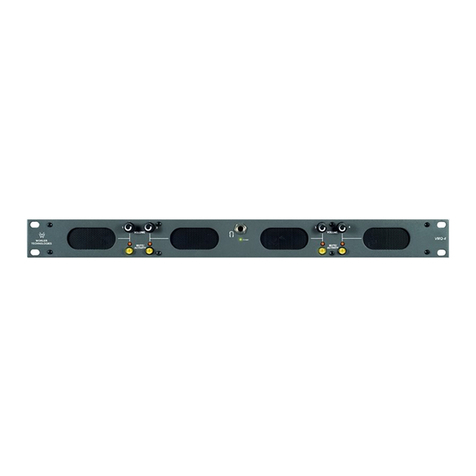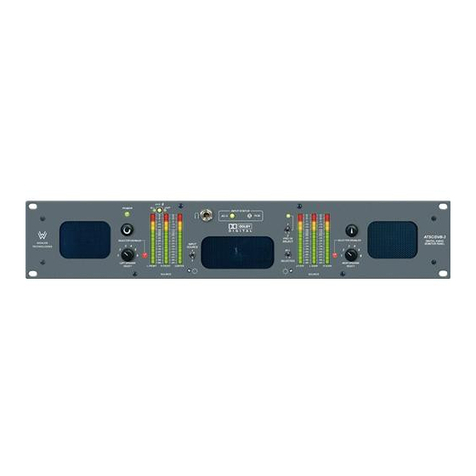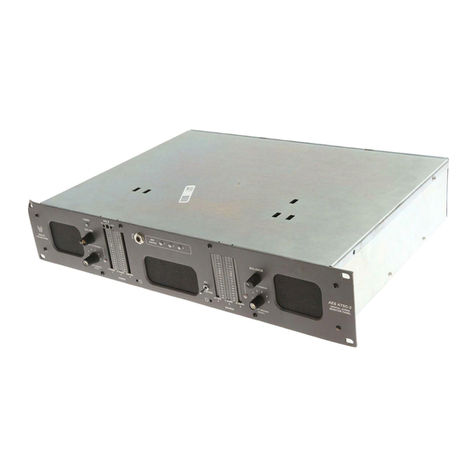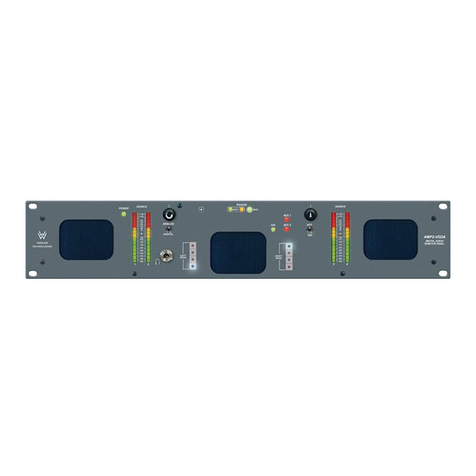
© 2004 Wohler Technologies Inc. ALL rights reserved
4
AMP1-VSD User Manual P/N 821615, Rev-A
Features
AMP1-VSD
Powered Digital Audio Monitors
Description
Section 1: Features , Specs, and Installation
AMP1-VSD Front Panel
The rackmountable 1U size AMP1-VSD audio monitor is capable of audibly monitoring up to four audio source channels through
its stereo speaker system while simultaneously visually monitoring the audio levels via four high-resolution 26-segment LED
bargraph level meters. The AMP1-VSD monitors digital SDI and AES audio sources. A toggle switch on the front panel allows
selection between AES or SDI input sources.Two banks of four buttons on the front panel are used to independently assign from
one to four (summed) channels to each of the two (left and right) speaker channels. SDI signal status is indicated by one bi-color
(red/green) LED and AES signal status is indicated by two bi-color (red/green) LEDs. Wohler Technologies proprietary three-LED
stereo phase indication feature allows monitoring of phase relationships between the left and right speaker channels. Other features
include separate volume and balance controls, power indication LED, and headphone output. Output limiter circuits are incorporated
to protect the speakers, and extensive magnetic shielding allows placement immediately adjacent to video monitors with no color
impurities.
The rear panel of the AMP1-VSD features one SDI input and one SDI output on unbalanced BNC connectors, two AES outputs
(de-embedded from the SDI source) on two BNC connectors, two AES inputs on BNC connectors, four analog outputs (de-
embedded from the selected digital source) on four Phoenix connectors, and left and right analog outputs (of the channels
assigned to the left and right speakers) on two balanced XLR connectors.
All AMP1 Series units contain three audiophile-quality drivers and three power amplifiers; two amplifiers (and two speakers) that
reproduce midrange and high frequency information in stereo, and a third amp/driver combination (and two speakers) that handles
summed Low Frequency (LF) information below the 500 Hz crossover point. The AMP1 Series unique audio design has two
important advantages. First, it provides optimally focused sound in an Ultra Near Field tm (1 to 3 feet) environment. This allows
higher SPL for the operator while reducing overall ambient sound and adjacent bay crosstalk. Second, electronic rather than
acoustic cancellation of bass frequencies provides positive audible detection of reversed polarity (“out of phase”) audio feeds.
• Two banks of four push buttons for assigning single or
summed channels to the left and right speaker
• Headphone output
• Power indication LED
• One SDI input and one SDI re-clocked output on unbalanced
BNC connectors
• Two AES inputs on two unbalanced BNC connectors
• Two AES outputs (converted from the SDI source) on two
BNC connectors
• Four analog outputs (converted from the selected digital
source) on four Phoenix connectors
• Analog outputs (of the sources selected for speaker
monitoring) on two balanced XLR connectors
• One SDI signal status indication LED
• Two AES signal status indication LEDs
• Quick and easy installation: simply slide in the rack and
connect audio and AC power
• Numerous control and input options
• 98 dB SPL at two feet
• Only one rack space high
• Excellent high frequency response for positive detection of
background whine and noise
• Audible and visual indication of phase/polarity problems
• Thorough magnetic shielding for placement next to video
monitors
• Four 26-segment high-resolution tri-color bargraph level meters:
-Selectable Input Referrence Level (0, +4, +6, or +8 dBu)
-Selectable Display Mode (VU Only, VU/PPM, or PPM Only)
-Selectable Peak Hold (Manual, 3-Second, 10-Second, or Off)
-Selectable PPM Ballistics (Type I, Type II, DIN 45406, or
SSRT)
-Selectable alternate Bargraph Scales (Extended VU, VU,
BBC, NORDIC, DIN, or Custom)



